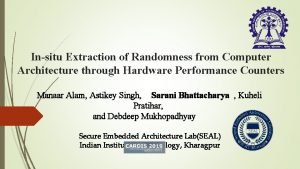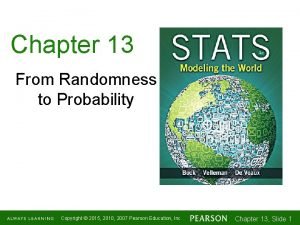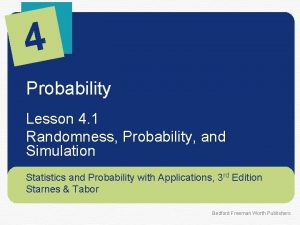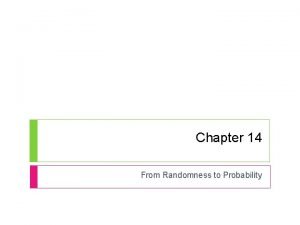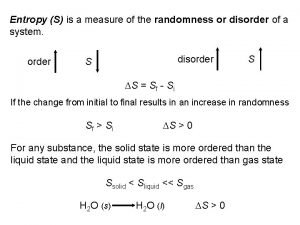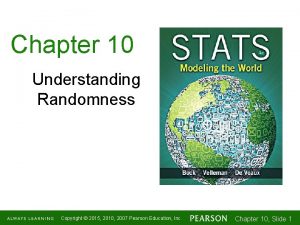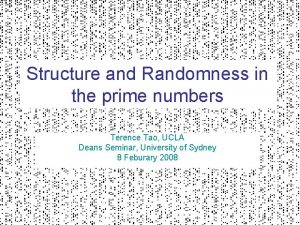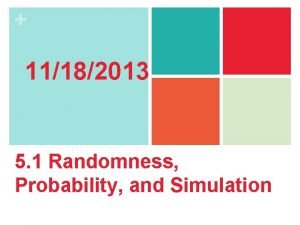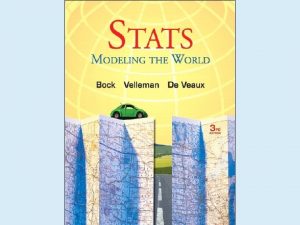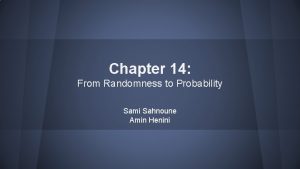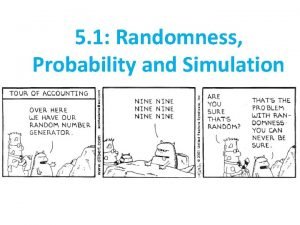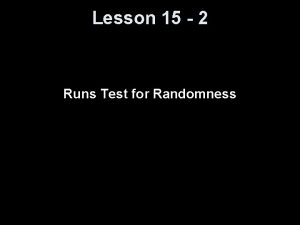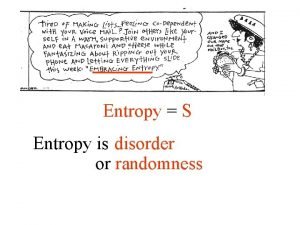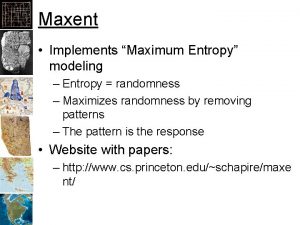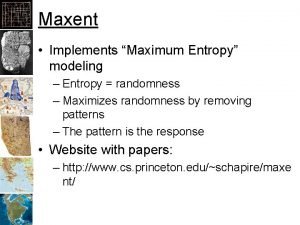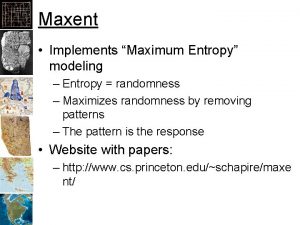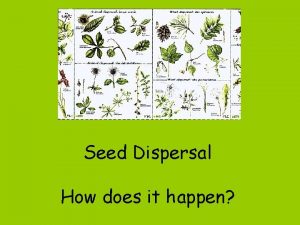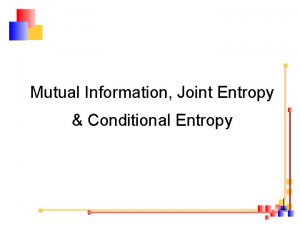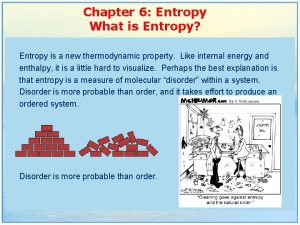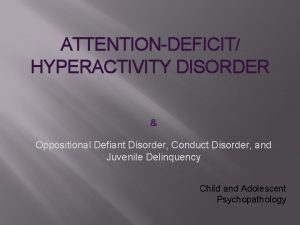Entropy S Entropy is disorder randomness dispersal of






![Entropy (J/K) [heat entering system at given T] convert q to S System 1 Entropy (J/K) [heat entering system at given T] convert q to S System 1](https://slidetodoc.com/presentation_image_h2/9eea0ae15fcd8065757c3386aadb0dd5/image-7.jpg)






- Slides: 13

Entropy = S Entropy is disorder randomness dispersal of energy

2 nd Law of Thermodynamics Suniverse > 0 spontaneous = for spontaneous processes no external intervention Ssystem positional disorder Ssurroundings energetic disorder

Energetic Disorder P. E. a) K. E. b) ordered reactants random a) endothermic reaction b) exothermic reaction P. E. products qsystem < 0 qsurroundings > 0 Ssurroundings > 0 Ssurr= - qsys T (J/K) Ssurr depends on T heat surroundings high T small effect low T relatively larger effect

Positional Disorder 2 dice microstates S = k. B ln W 2 3 4 5 6 7 8 9 10 11 12 k. B = R/NA distribution = state microstates = W= energy and position of atoms in state

W 2 W ∆S = S 2 – S 1 = k. Bln W 2/W 1 S = k. B ln W k. B = R/NA = k. B ln 2 x 2 for 1 mole gas ∆S = k. B ln 2 6. 02 x 10 23 = 6. 02 x 1023 k. B ln 2 = R ln 2 ∆SV 1→ V 2 = R ln (V 2/V 1)

Positional Disorder Boltzman S = k. B ln W ∆S = R ln (V 2/V 1) W = microstates ordered states disordered states low probability high probability low S high S Ssystem Positional disorder Increases with number of possible positions (energy states) Ssolids < Sliquids << Sgases
![Entropy JK heat entering system at given T convert q to S System 1 Entropy (J/K) [heat entering system at given T] convert q to S System 1](https://slidetodoc.com/presentation_image_h2/9eea0ae15fcd8065757c3386aadb0dd5/image-7.jpg)
Entropy (J/K) [heat entering system at given T] convert q to S System 1 Pext = 1. 5 atm w = -182 J q = +182 J T = 298 K System 2 Pext = 0 atm w=0 q=0 E = 0

System 3 P 1 = 6. 0 atm P 2 = 1. 5 atm V 1 = 0. 4 L V 2 = 1. 6 L T 1 = 298 K = T 2 Pext = Pint + d. P reversible process - infinitely slow n =. 10 V 2 wr= - Pext d. V = - n. RT d. V = - n. RT ln (V 2/V 1) V V wr= - n. RT ln(1. 6/4. 0) = - 343. 5 J 1

Ssystem System 1 Pext = 1. 5 atm w = -182 J q = +182 J S = 1. 15 J/K System 2 Pext = 0 atm w=0 q=0 S = 1. 15 J/K ∆S = n R ln (V 2/V 1) System 3 Pext = Pint + d. P wr = -n. RT ln (V 2/V 1) = - 343. 5 J qr = + 343. 5 J S = 1. 15 J/K qr = n R T ln (V 2/V 1) Ssystem = qr = 343. 5 J 298 K T ∆S = n CP ln (T 2/T 1) ∆S = n CV ln (T 2/T 1)

3 rd Law of Thermodynamics Entropy of a perfect crystalline substance at 0 K= 0

Entropy curve solid liquid gas vaporization S qr T fusion 0 0 Temperature (K)

Entropy At 0 K, S = 0 Entropy is absolute S 0 for elements in standard states S is a State Function Sorxn = n Soproducts - n Soreactants S is extensive

Increases in Entropy 1. 2. 3. 4. 5. 6. 7. Melting (fusion) Sliquid > Ssolid Vaporization Sgas >> Sliquid Increasing ngas in a reaction Heating ST 2 > ST 1 if T 2 > T 1. Dissolution ? Ssolution > (Ssolvent + Ssolute) Molecular complexity number of bonds Atomic complexity e-, protons and neutrons
 Somatic symptom disorder vs factitious disorder
Somatic symptom disorder vs factitious disorder Randomness in architecture
Randomness in architecture Ap statistics chapter 13 from randomness to probability
Ap statistics chapter 13 from randomness to probability Randomness probability and simulation
Randomness probability and simulation From randomness to probability
From randomness to probability A measure of the randomness in a system
A measure of the randomness in a system Chapter 10 understanding randomness
Chapter 10 understanding randomness Structure and randomness
Structure and randomness Randomness probability and simulation
Randomness probability and simulation Chapter 14 from randomness to probability
Chapter 14 from randomness to probability Chapter 14 from randomness to probability
Chapter 14 from randomness to probability Randomness probability and simulation
Randomness probability and simulation Run test for randomness example
Run test for randomness example Suppose you tear open the corner of a bag of m&ms
Suppose you tear open the corner of a bag of m&ms

